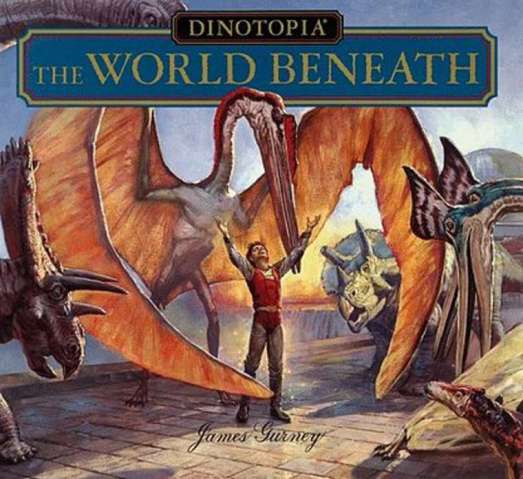Over the holidays I got the last of James Gurney’s amazing books in the Dinotopia series. If you don’t know anything about this series, drop what you’re doing and go check it out now. It’s beautiful and imaginative and captivating and was a big part of my childhood. I’ve been thinking for a long while about how to adapt this to an RPG and this time, immersed again in the wonder of Gurney’s world, it all started to finally click.
James Gurney has written four large books of oil paintings that make up the “canon” of Dinotopia. The first book published in 1992 is entitled Dinotopia (sometimes including the subtitle “A Land Apart From Time”) and tells the story of a Victorian-era scientist and naturalist named Arthur Denison who is washed ashore with his son Will and slowly finds his place in Dinotopian society. This is a “must-read” for people interested in the series: not just because it’s the original and best of these books but also because it introduces all the elements of the Dinotopia series step-by-step. The next book, The World Beneath (published in 1995), shows that Arthur Denison is still a little restless and he is trying to push the boundaries of Dinotopia society although he is repeatedly told (and eventually acknowledges) that changing a society that already functions smoothly and simply can lead to collapse.
Most notably, Arthur Denison’s exploration into underground caves finds giant, mechanized vehicles that are powered by mysterious sunstones. This is dealt with more fully in the third book First Flight (published 1999) which takes place in Dinotopia’s distant past (“four thousand years” is mentioned but that seems a little nuts). The empire of Poseidos in this time has pushed out dinosaurs from their offshore land and are conquering the Dinotopia mainland with their mechanized creations. There are strains of both Phyrexia and Avatar’s Resource Development Association in this and it’s clearly a cautionary tale to “modern” Dinotopians like Arthur Denison. In the fourth book Journey to Chandara (published 2007), Denison goes on one more journey to the reclusive southeast corner of the island where the removed (and orientalist) Empire of Chandara has been quietly doing it’s thing since the days of Poseidos as an alternate dinosaur utopia.
 Image © James Gurney
Image © James Gurney
There are many other books written by other authors and various sketches that Gurney himself has released but these four books offer so many of visual cues and plenty of information to construct a campaign around. Feel free to look through these other works, though, for inspiration (be prepared to negotiate inconsistencies, though) and look at anything regarding dinosaurs for additional info.
Game SystemWhen considering the game, you need to make an early decision about what skeleton this will be built on. I’ve pondered through a lot of different game systems and here are ones that I think could work well to capture the right mix of flexibility and accessibility for this game, as well as hitting the notes of cooperation and adventure that the Dinotopia books embody so well.
The things to worry about for a Dinotopia RPG are having a strong conflict system for non-violent encounters (there is some fighting in the Diontopia books but it’s not a hack-and-slash setting by any means) and also having a free-form system that can accommodate characters of different sorts (fantasy or pulp character archetypes won’t fit super-well). The biggest stumbling block, though, may be the dinosaur characters and how simply enormous they are. My ideal system would be one that supports for a human, a leptoceratops, and an amargasaurus in the same group without too much mechanical trouble.
First Choice: CortexOK, so Cortex is not everyone’s favorite and I’m not going to spend time now trying to convince you one way or another. If you have neutral feelings towards Cortex or if, like me, you like it then this seems like the best system to me by a fair margin. The Cortex Plus Hacker’s Guide has been out for a bit and gives you most everything you need and the Cortex Prime engine is in rapid development.
Second Choice: FATEThere is a lot to recommend FATE for running Dinotopia. First of all, it’s a flexible and easy system so that you can create very strange and different characters such as those seen in the books. If you want to create an irritable triceratops with scars from fighting tyrannosauruses or a blind Spanish trader washed up on shore, these are both just combinations of aspects. Aside from the flexibility in character generation, it’s a system that’s familiar to lots of players and one that has a lot of products to draw from. This makes it different from Cortex so you might decide that it’s your first choice and it certainly won’t disappoint.
 Image © James Gurney
Runners Up
Image © James Gurney
Runners Up
Besides those two, there are a few other systems that could work for Dinotopia.
- Cypher System: This system is exceptionally easy to adapt and write for and it already has “power shifts” which allow you to scale up or down. On the other hand, these shifts are intended to be static (everyone gets the same amount) but maybe you could houserule a trade-off? There are a lot of abilities that are either magical or technological so the ability list would shrink dramatically when you remove these and you’d have to write a bunch to bring them back up.
- Genesys System: The new Genesys system from Fantasy Flight Games is narrative and creative, just like James Gurney’s world, so it could make a great option. On the other hand, it’s pretty combative and bloody which doesn’t mesh as well. It’s possible that this would work just fine but I just don’t know enough about it right now.
- Kids On Bikes: This new game coming out from a recent Kickstarter looks really promising and great, and it might be a good fit for Dinotopia as well. Without a full rulebook, though, it’s hard to say for certain.
- Mouse Guard: This might be a better framework in some ways and for some groups. The dynamic social interaction system and travel mechanics are both great fits for Dinotopia and there’s already a scale system for different animals (although this mostly affects combat). On the other hand scale isn’t for PCs and would make them super-powerful so you’d have to write a lot of new rules.
- Tales From the Loop: This is a dynamic and fun system and there are even dinosaurs in it! However, there aren’t rules for actually playing dinosaurs and not even an easy way to make non-human characters. You can borrow from other Fria Ligan products, of course, but this is a lot of homebrewing.
Dinosaurs end up on the island and slowly evolve to be sentient with their own languages and cultures. They don’t change much at all physically and earlier species exist alongside later species in a way that never happened in the wider world. Don’t delve really deeply into this, it’s probably not worth it and if you start cracking this foundation it undermines the whole setting. Just go with it: we gave you dinosaurs to befriend for crying out loud!
After the dinosaurs had established a functional, balanced ecosystem (and got through the Ice Age) humans started showing up on the island. They were mostly shipwreck victims, carried to shore by helpful dolphins who may or may not be smarter than other dolphins. Being surrounded by a ring of difficult shoals and reefs, a higher-than-average number of ships are destroyed during storms around Dinotopia. Even if someone managed to get a ship to Dinotopia (and there’s ample evidence that at least some outside stuff gets through) getting back out through the underwater barriers is difficult at best. Despite this, there are mentions of people getting back out again in the books, most notably a dinosaur named Djehuty who reached ancient Egypt (from First Flight).
Sometime in the past, a period called the Age of Heroes by later Dinotopians, there was a time of mighty empires fighting for control of the island. Poseidos (the source of the mechanized strutters in The World Beneath and the main enemy in First Flight) was a realm of machines which rejected the idea of living alongside dinosaurs. They had extremely advanced technology (including versions of robots and anti-gravity vehicles) which were powered by mysterious sunstones. In my head-canon they come from lost Atlantis and are more cargo cult than scientific geniuses, using the strange (extraterrestrial?) sunstones through trial-and-error and becoming addicted to the godlike rush of creating new things.
The Empire of Poseidos mostly clashed with the Pelledrine, allied tribes in the island’s center that had befriended dinosaur groups including large meat-eaters with which they organized a guerilla resistance to Poseidos’s expansion. Mostly they favored low-scale troublemaking (I imagine things like The Monkey Wrench Gang) but there was a group called the Saurian Knights who donned plate armor, strapped on broadswords, and rode tyrannosaurs out against the mechanized expansionists. Nice.
 Image © James Gurney
Image © James Gurney
The two other great forces of the time were isolated and apparently mostly neutral: Chandara in the semi-arid southeast was a place of ceremony and tradition with both humans and dinosaurs, while Armakia in the mountains at the island’s center was a snow-capped land of Ice Age mammals.
Eventually, and here’s where I’m interpreting a lot, Poseidos is defeated and the Pelledrine way comes,t on dominate the island. The Armakians are ready allies but are mostly left to their own devices in the mountains. The Chandarans, however, become even more isolated but make no move to upset the status quo. This is stretching canon but to me it seems likely that the Pelledrines and their allies,buried all the Poseidos tech in the World Beneath and their cautionary tales eventually turned to legends of death and hauntings. By the time of Arthur Dennison’s expedition, no one can give an articulate reason for him not to go but they are all vaguely unsettled by the idea due to the collective memory of Poseidos’s war. When the Dennisons arrive, Dinotopia has been ingrained with a timelessness that will surely last. You could set your Dinotopia game contemporary with any external period from the 16th century to the 21st and expect the local landscape to be much the same.
Advertisements Share this:




